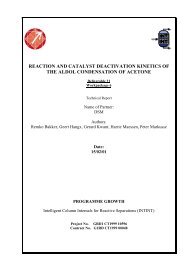REACTION KINETICS OF THE ESTERIFICATION OF ETHANOL ...
REACTION KINETICS OF THE ESTERIFICATION OF ETHANOL ...
REACTION KINETICS OF THE ESTERIFICATION OF ETHANOL ...
Create successful ePaper yourself
Turn your PDF publications into a flip-book with our unique Google optimized e-Paper software.
Intelligent Column Internals for Reactive Separations Page 2 of 5<br />
Deliverable 22 Issued: 24.08.01<br />
1 SUMMARY AND CONCLUSIONS 2<br />
2 INTRODUCTION 2<br />
3 EXPERIMENTAL 3<br />
4 RESULTS AND DISCUSSION 3<br />
5 LIST <strong>OF</strong> SYMBOLS 5<br />
6 SELECTION <strong>OF</strong> PHYSICAL PROPERTIES 5<br />
1 Summary and conclusions<br />
The kinetic parameters have been determined for INTINT reaction system 3: ethanol/acetic<br />
acid/ethyl acetate. The reactions considered are the esterification of ethanol (CH3CH2OH, EtOH)<br />
and acetic acid (CH3COOH, AcOH) towards ethyl acetate (CH3COOCH2CH3, EtOAc) and water,<br />
and the reverse reaction, ester hydrolysis. The catalyst used is the cation exchange resin Purolite<br />
CT179.<br />
2 Introduction<br />
The work described in this report is a part of the European project “Intelligent Column Internals for<br />
Reactive Separations” (INTINT). The report contains the kinetics of reaction system 3. Originally,<br />
reaction system 3 was the aldol condensation of acetone towards diacetone alcohol. However, since<br />
no stable catalyst for this reaction was available 1 , this process was abandoned. The reaction studied<br />
instead is the esterification of ethanol (CH3CH2OH, EtOH) and acetic acid (CH3COOH, AcOH),<br />
resulting in the products ethyl acetate (CH3COOCH2CH3, EtOAc) and water, see equation 1:<br />
O<br />
OH<br />
+<br />
HO<br />
H + H +<br />
AcOH EtOH EtOAc<br />
This reaction is reversible, and the equilibrium composition is a weak function of temperature. The<br />
reaction is acid catalysed, and as for most esterifications usually strong mineral acids (hydrochloric<br />
acid, sulfuric acid) are used 2,3 . Cation exchange resins (typically containing sulfonic acid groups,<br />
e.g. Amberlyst 15, Purolite CT179) are also widely used, because of their high activity and selectivity<br />
(possible side reactions are alcohol dehydration and etherification), and easy separation 2 . Catalyst<br />
deactivation appears to be negligible. In practice the equilibrium is often forced towards the<br />
1 INTINT deliverable 21, February 2001<br />
2 Ullmann’s Encyclopedia of Industrial Chemistry, vol. A9<br />
3 Chemical Economics Handbook CD-ROM<br />
O<br />
O<br />
+ H 2 O<br />
(1)




